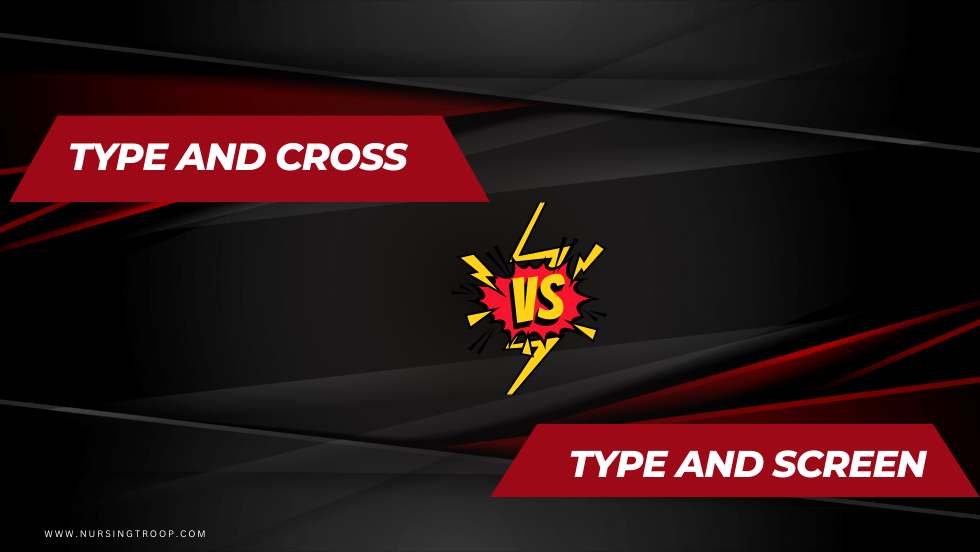When it comes to blood transfusions, two main types of procedures are used to ensure that the right blood type is being transfused into the patient. The first is called a type and cross, and the second is a type and screen. Both procedures have some advantages and disadvantages. It is vital to understand both to make the best decision for your case.
Table of Contents
Type and Crossmatch & Type and Screen?
Type and Crossmatch
It is a test done to see the donor’s blood type and make sure it is compatible with the patient’s blood type. The test is done by taking a small sample of blood from the patient and adding it to a blood tube from the potential donor. If the patient’s and donor’s blood mix and form clumps, it is incompatible, and the donor cannot give blood to the patient. If the blood does not form lumps, it is compatible, and the donor can give blood to the patient.
This kind of test is performed when a patient needs a blood transfusion urgently. In an emergency situation, there is no time to do a more thorough examination. It takes less than 15 minutes to get a type and crossmatch results.
Type and Screen
This is a test that is performed to determine a donor’s blood type (A, B, AB, or O) and whether or not they have the Rh factor. The Rh factor is a protein found on the surface of red blood cells. If a person has the Rh factor, they are said to be Rh-positive. If they do not have the Rh factor, they are Rh-negative. The test can also tell if a person has antibodies to the Rh factor. If a person has these antibodies, they may react if they receive blood from someone who is Rh-positive.
When there is some time then this
This type of test is performed when there is some time to do a more thorough test, such as when a person is scheduled for surgery. It is also sometimes done on pregnant women to determine if Rh incompatibility is a risk between the mother and the baby. It takes about 15 to 30 minutes to get a type and screen results.
Procedure for each Type and Crossmatch Vs. Type and Screen
Type and Crossmatch
A small amount of blood is taken from the patient. The blood is then mixed with a blood sample from the potential donor. If the blood forms clumps, it is incompatible, and the donor cannot give blood to the patient. If the blood does not form lumps, it is compatible, and the donor can give blood to the patient. It will take 15 minutes or less to get results from this test.
Type and Screen
A small amount of blood is taken from the donor. The blood is then tested for the ABO blood type and the Rh factor. A test is also done to see if the donor has antibodies to the Rh factor and if the donor is Rh-positive. It will take 15-30 minutes to get results from this test.
Pros and Cons of Type and Cross
Pros
- It can be done quickly
- Can save a life in an emergency
- It can be used to match blood for transfusions and organ transplants
Cons
- It is not as accurate as other tests
- It can only be used to match blood for transfusions and other emergencies.
- The cost of the test may be higher than other tests.
Pros and Cons of Type and Screen
Pros
- More accurate than a type and cross matches
- It can be used to match blood for transfusions, organ transplants, and pregnancy.
- It costs less than a type and cross matches
Cons
- It takes longer to get results
FAQs:
Why do you need two types and screens?
You may need two types and screens if you are pregnant or scheduled for surgery.
If you are pregnant, your doctor may order a type and screen to check for Rh incompatibility between you and your baby.
If you are scheduled for surgery, your doctor may order a type and screen to check for compatibility between your blood and the donor blood used during surgery.
How long do types and screens last?
Type and screens last for up to one year. After one year, you will need to have another type and screen if you need a blood transfusion or are scheduled for surgery.
Do you need type and screen for platelets?
No, you do not need a type and screen for platelets. Platelets are a type of blood cell that helps your blood clot. They can be transfused without being matched for blood type.
How often do you need type and cross?
If someone gets into an emergency and needs a blood transfusion, they will need a type and cross.
What are the most common blood tests?
There are numerous blood tests available. Specific tests, such as complete blood count tests, basic metabolic panels, complete metabolic panels, and electrolyte panels, simultaneously assess multiple elements in your blood. Conversely, other blood tests target particular elements in your blood.
Conclusion- which is better?
There is no clear answer to decide which test is better. It depends on the individual situation. If someone needs a blood transfusion quickly, they will need a type and cross. If someone has time to wait for results, they may be able to have a type and screen. Ultimately, it is up to the doctor to decide which test is best for the patient.
Mrs. Marie Brown has been a registered nurse for over 25 years. She began her nursing career at a Level I Trauma Center in downtown Chicago, Illinois. There she worked in the Emergency Department and on the Surgical Intensive Care Unit. After several years, she moved to the Midwest and continued her nursing career in a critical care setting. For the last 10 years of her nursing career, Mrs. Brown worked as a flight nurse with an air ambulance service. During this time, she cared for patients throughout the United States.

